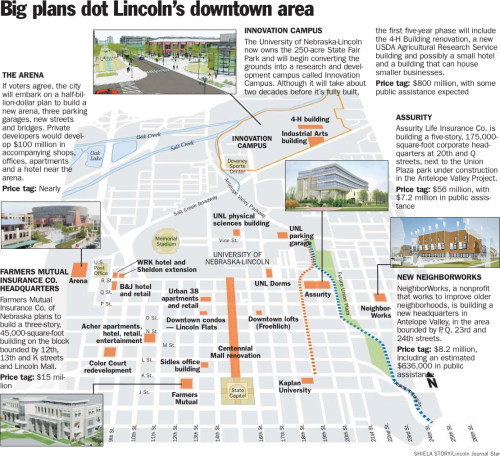Nebraska Plans $1.8 Billion Transformation for Lincoln
As the nation struggles to emerge from recession, Lincoln has $1.8 billion in projects planned in the downtown area alone.
The development boom is bookended by a proposed new city arena west of downtown and a new $56 million corporate headquarters for insurance company Assurity under construction to the east and topped off to the north by an $800 million renovation of the state fairgrounds into a research and development campus by the University of Nebraska-Lincoln.
 City planner and historian Ed Zimmer said a $1.8 billion transformation would be one for the history books. It smacks of the 1910s and 1920s, he said, when city boosters bandied about the slogan "A New Skyline Every Morning" after more than a half dozen buildings went up downtown between 1912 and 1927, including the Sharp and Stuart buildings.
City planner and historian Ed Zimmer said a $1.8 billion transformation would be one for the history books. It smacks of the 1910s and 1920s, he said, when city boosters bandied about the slogan "A New Skyline Every Morning" after more than a half dozen buildings went up downtown between 1912 and 1927, including the Sharp and Stuart buildings.
The difference is, those buildings weren't all on the drawing boards simultaneously and weren't whole campuses or neighborhoods, Zimmer said.
In the mid to late 1980s, two developers tried to launch a major downtown project involving six blocks from O to Q and 10th to 13th streets, Zimmer said. But that paled in comparison to current proposals, he said.
The mayor's economic development coordinator, Mike Lang, says: "You don't have to be a rocket scientist to realize the downtown area is getting a lot of activity.
"We've got a lot of potential to change the landscape in a very positive way."
Cecil Steward, an expert on sustainable development, past president of the American Institute of Architects and a downtown advocate, says this is an ideal time to embark on ambitious projects, since Lincoln and Nebraska escaped the brunt of the recession.
"I think labor is more available, materials are cheaper, construction companies are more available, and bid prices are lower," Steward said.
Not only are the city and university behind the biggest projects, but almost all of the private projects are slated to get city assistance in the form of tax increment financing.
"The more you can leverage public funds and assist private financing, the less recession you will have," Steward said.
However, Lincoln construction magnate Joe Hampton says private projects "get watered down a little" when they use TIF, which plows the increased property tax revenue generated by redevelopment back into the projects, rather than government coffers. The city generally doesn't get the taxes for 15 years.
"But the reality of it is you gotta compete on a national level, and that is a tool we've got to work with," Hampton said.
Seven-year-old development company WRK has a hand in about $150 million worth of projects planned and under way in downtown Lincoln.
WRK co-owner Will Scott says Lincoln is experiencing a "perfect storm" with the arena and Innovation Campus coming together at the same time.
He and his twin brother, Robert, are on a mission to bring "24-hour vitality" to downtown Lincoln. And while they have a lot of projects in the works, Will Scott says, "We wouldn't ever swim out farther than we could swim back."
WRK gets a lot of horsepower from its partner in several projects, a national company based in Utah called Woodbury Corp.
Woodbury sees a lot of potential in Lincoln. Zach Wiegert, a former Nebraska and NFL football player who is a lead developer for Woodbury, recently said a lot of developers can't get financing right now, but Lincoln has a stable market and Woodbury is a 100-year-old company with the resources to do the projects.
However, a half-billion-dollars in construction - the arena project and associated stores, offices, a hotel and restaurants - hinges on voter approval, and other projects now proposed may never come to fruition.
After all, one of the projects is a scaled-down second try at developing a half-block the city razed a few years ago for a $180 million, three-skyscraper plan that fizzled. The new $27 million plan is a nine-floor building with 48 apartments on top of a new city parking garage between 13th and 14th, Q and P streets.
Lincoln developer Monte Froehlich was involved in the initial, bigger plan. He even bought a Chinese restaurant for $730,000 to help the city clear the way for redevelopment. But ultimately it proved too difficult for his development team to get financing.
Froehlich has since embarked on several smaller downtown condo projects, including a recent $1 million renovation of the W.C. Shinn building near 16th and O streets into 14 loft-style apartments.
Froehlich thinks Lincoln has benefitted from slow, steady growth downtown.
"I think Lincoln's pretty conservative, so in our recent history we haven't had anyone that's just gone crazy and overbuilt," he said. "Fourteen units is not like in Omaha when hundreds hit the market and really killed the market."
Hampton, 85, has been in the construction business since arriving in Lincoln in 1947. He said Lincoln's home-building business is in shambles and the private sector is generating very little activity, but nonprofits, education and government keep things moving.
"Lincoln's doing better than most," he said. "It's a government town."
He said Lincoln also benefits from a good work ethic and ample, affordable water and electricity.
Steward said if all of the projects are built, from the arena to Innovation Campus, they won't just change the look of Lincoln.
"It'll change the perception of what's possible in this city," he said. "Once we get these kinds of solid projects up and going, I think the country will take notice."
Some are already noticing, he said. Lincoln is competing with Austin, Texas, to host an annual meeting of CEOs of major corporations after being suggested by one of the big players.
"That's a sign people are paying attention," Steward said. "They're coming to realize that not everything happens on the coast."
For a map of the proposed downtown projects, click here.
Source: JournalStar.com
















